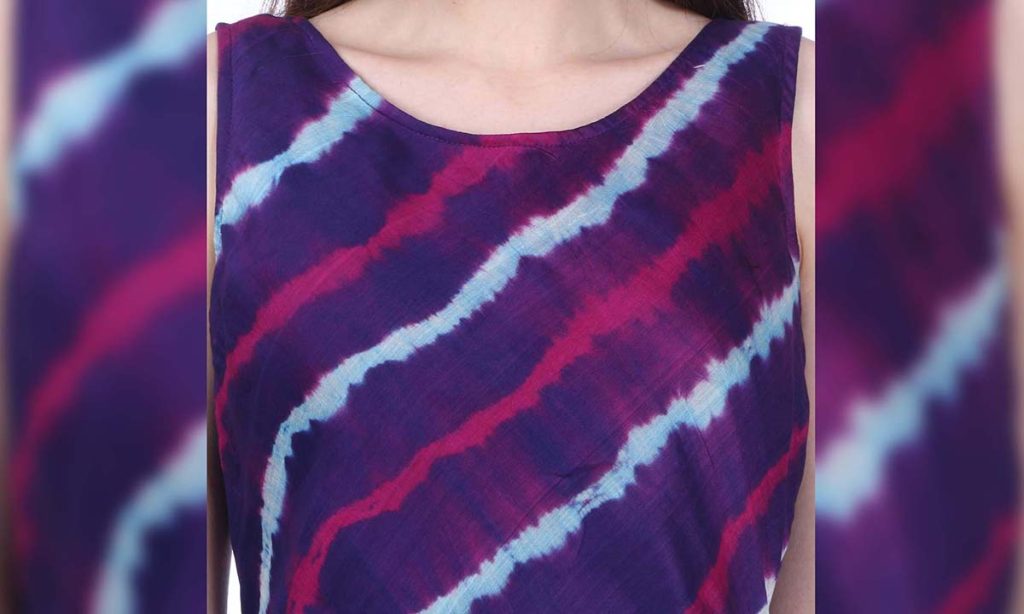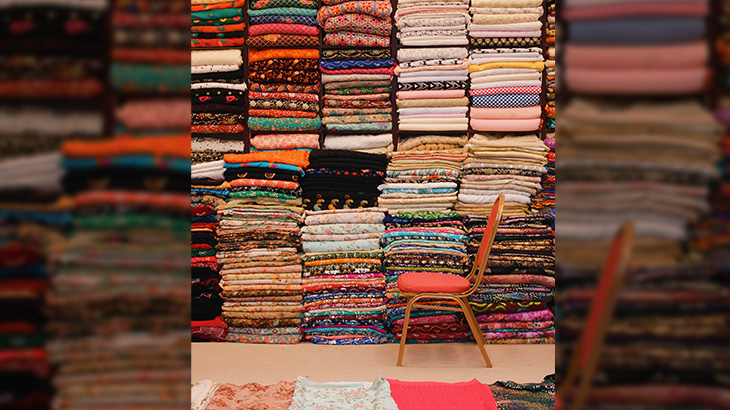Painting is deep as eternity; the fabric is hollow as time. When there is a fusion of these, we get something that is even better in the form of simple fabric painting designs.
From standard patterns such as the peace sign, spiral, diamond and the marble effect to beautiful works of art, the Tie-dye technique can be used for the creation of a wide variety of designs on fabric.
Materials Needed to Carry Out Tie-dye Technique:
- Cotton dyes
- Old pan for dyeing
- Clean pan for soaking
- Water
- Common Salt
- Washing Soda (optional)
- Colour fixers (optional)
- Gas stove and lighter
- Small scissors
Tie Methods to Get Simple Fabric Painting Designs:
1. Marbling/ Krumping/ Crushing
Scrunch fabric using both hands and then loosely band together with rubber bands.
2. Central/Circle Tie
In this method, you need to hold the fabric from the centre tie at intervals.
3. Sew and Draw, Tacking, Basting
In this method, the fabric is folded lengthwise and then a half rectangle is marked on the on fold side of the fabric. The rectangle is then gathered with the help of a running stitch and finally, the thread is tied tightly.
4. Triangle Fold and Tie
Make wide pleats out of the fabric.
Then make a triangular fold from one end and continue folding till another end of the fabric.
Tie the fabric tightly using thread.
5. Itajime Technique / Sandwich Tie
In the Itajime technique, which is a simple fabric painting designed for sarees, we clamp the folded fabric between two objects. Rubber bands, strings or woodwork clamps may work. The pattern on the fabric is affected by the way you fold the fabric. You can try several different folding techniques such as a wedge or square and also attach several clamps to create the patterns. Light cotton gives excellent results.
6. Tiny Dots
This is the Indian technique, tying small circles in the cloth with thread so that the final pattern is a series of dots. The fabric (fine muslin) is folded in four, and all four layers were tied at the same time. This saves time and effort. The maker does not cut the thread after binding each circle, but continues the next circle using the same thread. So it is very easy to remove the thread – simply by stretching the muslin out on each side, the tension causes the threads to pop off.
7. Lehariya Tie

source: amazon.in
The fabric is rolled diagonally into a coil, tied at regular intervals, and then dyed. When unrolled, the result is a diagonally striped fabric. Lahariya means waves, and this pattern is especially popular for clothing during the monsoon season.
8. Twist and Tie
First, make the pleat out of fabric.
Then handle it from two ends and start twisting the fabric.
Twist it till it becomes half the length of the original and then tie it at intervals.
9. Mothara
Mothara is a simple fabric painting design technique that is quite similar to lahariya but involves an additional step in the process. At a 90 degree angle to the original, the lahariya is again rolled into a coil and then it is tied and dyed again. The defining characteristic of mothara is the display of the subtle plaid or checked design which is witnessed when the fabric is unrolled.
Pigments are colouring matters which are not absorbed by fibres but are attached to their surface by using fixers and binders.
Dyes are colouring matters absorbed by fibres and are used for the creation of simple outline fabric painting designs.
Dyes are further classified into
- Readymade dyes: These possess colour in their powder or liquid form even before application on fibres. E.g. direct dyes used for tie and die.
- Ingrain dyes: These do not show their actual colour before application. Their colour is developed inside the fibre. E.g. azoic dyes used in batik.
Readymade Dyes
There are two types of readymade dyes
a) Water Soluble Dyes: These are used by dissolving in water. E.g. direct dyes.
b) Water Insoluble Dyes: Insoluble dyes are dyes that are not soluble in water. These have to be either reduced to soluble form or applied from a dispersion rather than a solution. E.g. sulphur dyes, vat dyes and disperse dyes. Let’s take a look at water-insoluble dyes one by one to know how they can help to obtain simple fabric painting designs.
1. Sulphur Dyes
- Sulphur dyes contain disulphide in their chemical structure.
- The most important class of sulphur dyes is sulphur black.
- Commercially successful black sulphur was first prepared in 1893.
- Due to their strong alkaline condition, sulphur dyes are not applicable to wool or protein fibres.
2. Vat Dyes
- These dyes were earlier applied from wooden vats.
- Fibres most readily dyed with these are man-made cellulosic. These are the fastest dyes for cellulosic fibres.
- These have excellent fastness.
- Earlier natural vats were used of which indigo finds the first mention.
- These are expensive dyes.
- Application method is the same as sulphur dyes.
3. Disperse Dyes for Making Simple Outline Fabric Painting Designs
- These are applied by dispersion in water, not in a solution.
- Their structure is non-ionic. These do not have charged cationic or anionic groups within the structure.
- These have the smallest molecule among all dyes.
- These are applied mainly on hydrophobic fibres such as cellulose acetate, polyamide (nylon), polyester and acrylic. But mostly on polyester and acetate.
- These can undergo sublimation i.e. change to vapours directly from solid. That is why these can be used for transfer printing.
Pros of Using Tie-dye Technique for Simple Fabric Painting Designs:
- Mostly, hot water is used for dyeing.
- In the tie-dye technique production takes less time.
- To purchase materials for production, less money is required.
- Materials used are easily available.
- No requirement for freehand design sketching.
Cons of Using Tie-dye Technique for Simple Fabric Painting Designs:
- Not easily suitable for wall hanging.
- Limited designs in production.
- Less intricate lines can be achieved.
- Crackles are less pronounced.
Only a few can master the art of simple fabric painting designs and you too can be among those few with the help of the above-mentioned techniques and our simple fabric painting designs for sarees courses.
Also Read: Fabric Designing and its Techniques
At Hunar Online, you will get access to detailed video lessons and can learn from anywhere. You will get 24/7 faculty support and a chance to learn from the experts of the industry. Also, watch our trial classes and get a glimpse of our courses. You can start learning your favourite course by downloading the app.
So, what are you waiting for? Join Hunar Online Courses and do what you always wanted to do.



